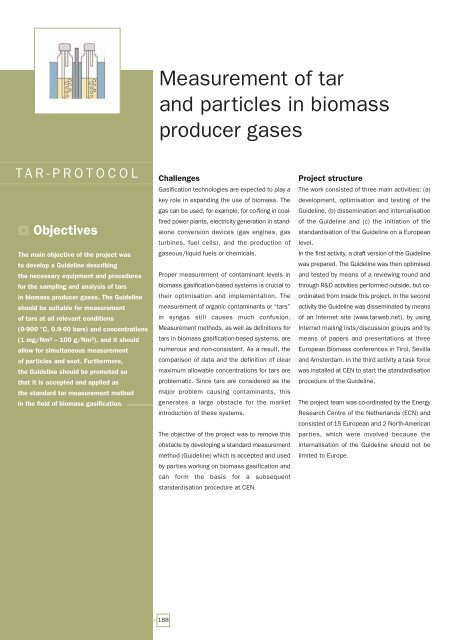European Bio-Energy Projects
European Bio-Energy Projects
European Bio-Energy Projects
You also want an ePaper? Increase the reach of your titles
YUMPU automatically turns print PDFs into web optimized ePapers that Google loves.
T AR-PROTOCOL<br />
Objectives<br />
The main objective of the project was<br />
to develop a Guideline describing<br />
the necessary equipment and procedures<br />
for the sampling and analysis of tars<br />
in biomass producer gases. The Guideline<br />
should be suitable for measurement<br />
of tars at all relevant conditions<br />
(0-900 °C, 0.9-60 bars) and concentrations<br />
(1 mg/Nm3 – 100 g/Nm3), and it should<br />
allow for simultaneous measurement<br />
of particles and soot. Furthermore,<br />
the Guideline should be promoted so<br />
that it is accepted and applied as<br />
the standard tar measurement method<br />
in the field of biomass gasification.<br />
Measurement of tar<br />
and particles in biomass<br />
producer gases<br />
Challenges<br />
Gasification technologies are expected to play a<br />
key role in expanding the use of biomass. The<br />
gas can be used, for example, for co-firing in coalfired<br />
power plants, electricity generation in standalone<br />
conversion devices (gas engines, gas<br />
turbines, fuel cells), and the production of<br />
gaseous/liquid fuels or chemicals.<br />
Proper measurement of contaminant levels in<br />
biomass gasification-based systems is crucial to<br />
their optimisation and implementation. The<br />
measurement of organic contaminants or “tars”<br />
in syngas still causes much confusion.<br />
Measurement methods, as well as definitions for<br />
tars in biomass gasification-based systems, are<br />
numerous and non-consistent. As a result, the<br />
comparison of data and the definition of clear<br />
maximum allowable concentrations for tars are<br />
problematic. Since tars are considered as the<br />
major problem causing contaminants, this<br />
generates a large obstacle for the market<br />
introduction of these systems.<br />
The objective of the project was to remove this<br />
obstacle by developing a standard measurement<br />
method (Guideline) which is accepted and used<br />
by parties working on biomass gasification and<br />
can form the basis for a subsequent<br />
standardisation procedure at CEN.<br />
188<br />
Project structure<br />
The work consisted of three main activities: (a)<br />
development, optimisation and testing of the<br />
Guideline, (b) dissemination and internalisation<br />
of the Guideline and (c) the initiation of the<br />
standardisation of the Guideline on a <strong>European</strong><br />
level.<br />
In the first activity, a draft version of the Guideline<br />
was prepared. The Guideline was then optimised<br />
and tested by means of a reviewing round and<br />
through R&D activities performed outside, but coordinated<br />
from inside this project. In the second<br />
activity the Guideline was disseminated by means<br />
of an Internet site (www.tarweb.net), by using<br />
Internet mailing lists/discussion groups and by<br />
means of papers and presentations at three<br />
<strong>European</strong> <strong>Bio</strong>mass conferences in Tirol, Sevilla<br />
and Amsterdam. In the third activity a task force<br />
was installed at CEN to start the standardisation<br />
procedure of the Guideline.<br />
The project team was co-ordinated by the <strong>Energy</strong><br />
Research Centre of the Netherlands (ECN) and<br />
consisted of 15 <strong>European</strong> and 2 North-American<br />
parties, which were involved because the<br />
internalisation of the Guideline should not be<br />
limited to Europe.

















